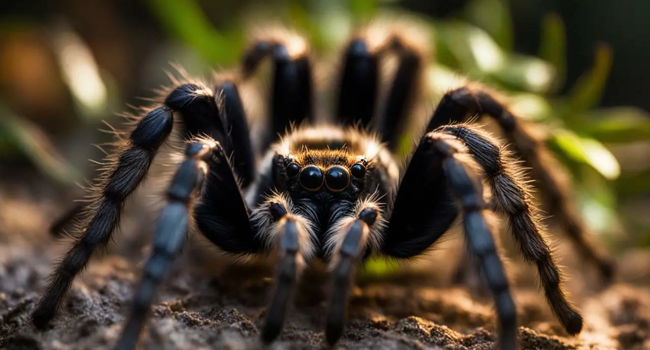Tarantulas, often feared and misunderstood, are fascinating creatures with unique behaviors and characteristics. Let’s delve into the mysterious world of these eight-legged wonders.
Introduction
Tarantulas are giant arachnids belonging to the family Theraphosidae. With their robust bodies and distinctive eight legs, they are among the most recognized members of the arachnid family. These creatures have captured people’s imaginations worldwide, and in this article, we will delve deeper into their intriguing behavior.
Appearance
Tarantulas come in a variety of sizes and colors. They are known for their hairy bodies and large fangs. These features not only give them a unique appearance but also serve essential functions in their lives.
Natural Habitat
Most tarantulas are found in tropical and subtropical regions, with diverse habitats, including deserts, rainforests, and grasslands. Understanding their natural habitat is crucial to comprehend their behavior in the wild.
Tarantula Behavior
Tarantulas exhibit a wide range of behaviors that make them intriguing study subjects.
Solitary Creatures
Tarantulas are typically solitary creatures, preferring to lead a solitary life. They come together primarily for mating purposes, after which they part ways. This reclusive behavior sets them apart from many other arachnid species.
Web Spinning
While not all tarantulas create webs for hunting, some species spin silk to make burrows or trap prey. The use of silk and the intricacy of their holes are fascinating aspects of tarantula behavior.
Predatory Nature
Tarantulas are skilled predators, using their venomous fangs to immobilize prey. Understanding their predatory nature helps us appreciate their essential role in controlling insects in their ecosystems.
Communication Through Vibrations
Tarantulas use vibrations to communicate with each other. Whether it’s courtship, warning of danger, or claiming territory, these vibrations are their language. This unique communication method adds depth to their behavior.
Mating and Reproduction
Mating for tarantulas is a delicate process. The male must approach the female cautiously, as she may perceive him as a potential meal—successful mating results in the creation of egg sacs, each containing hundreds of eggs. The maternal care and protection of these eggs is another intriguing aspect of their behavior.
Lifespan and Growth
Understanding the lifespan and growth stages of tarantulas is essential for appreciating their behavior. From tiny spiderlings to full-grown adults, each step brings its behaviors and challenges.
Defense Mechanisms
Tarantulas have developed various defense mechanisms to protect themselves. From urticating hairs to venomous fangs, these creatures have an arsenal of tools to deter predators.
Common Misconceptions
Addressing common misconceptions about tarantulas is essential for dispelling fear and misunderstanding. This section will provide clarity on some of the myths surrounding these creatures.
Tarantulas as Pets
Owning a tarantula as a pet is a growing trend. In this section, we will discuss the care and responsibilities associated with keeping tarantulas in captivity.
Choosing the Right Species
Selecting the suitable species for a pet tarantula is a crucial decision. Not all tarantulas are ideal for beginners, and understanding the choices available is vital.
Goliath Bird-Eating Tarantula
One of the largest tarantula species, the Goliath Bird-Eating Tarantula, is a marvel of the arachnid world. We will explore its behavior and characteristics.
Mexican Redknee Tarantula
Known for its striking red markings, the Mexican Redknee Tarantula has a unique set of behaviors that set it apart. We will delve into its world in this section.
Conservation Efforts
Tarantulas face various threats in the wild, from habitat loss to illegal wildlife trade. This section will highlight conservation efforts aimed at protecting these fascinating creatures.
The Role of Tarantulas in Ecosystems
Understanding the ecological role of tarantulas is essential. They help control insect populations, contributing to the balance of their ecosystems.
Impact on Human Culture
From ancient myths and folklore to modern literature and movies, tarantulas have left a significant mark on human culture. We will explore their influence in this section.
Research and Discoveries
Ongoing research reveals new insights into tarantula behavior and biology. We will touch upon some of the latest discoveries in the world of technology.
Tarantula Venom and Its Effects
One of the most intriguing aspects of tarantulas is their venom. While most tarantula bites are not life-threatening to humans, the composition of their venom varies among different species. Some species have venom potent enough to immobilize prey, while others use it primarily for defense. The diversity in venom composition and its effects on different prey items offer a fascinating study area for scientists and arachnologists.
Tarantulas and Environmental Balance
Tarantulas are essential players in maintaining the ecological balance in their natural habitats. By preying on insects and other small creatures, they help control pest populations. This vital role in the food web ensures that ecosystems remain healthy and in equilibrium. As we understand the interconnectedness of all living beings on our planet, we begin to appreciate the significance of these eight-legged creatures.
The Art of Tarantula Silk
Beyond their role as predators, tarantulas exhibit remarkable silk-spinning abilities. Some species create intricate silk burrows, while others use their silk for web construction. These silken creations are not only engineering marvels but also provide critical functions in a tarantula’s life, including shelter, protection, and prey capture.
Tarantulas in Myth and Legend
Throughout history, tarantulas have featured prominently in myths, legends, and folklore worldwide. Their mysterious appearance and behaviors have led to various interpretations and cultural significance. We’ll explore some captivating stories and beliefs associated with tarantulas, from ancient civilizations to contemporary culture.
The Future of Tarantula Research
The study of tarantula behavior is an evolving field. Ongoing research continues to unveil new insights into their biology, ecology, and behavior. From technological advancements to collaborative efforts among scientists, the future promises to uncover more secrets about these enigmatic creatures. The knowledge gained from this research will not only deepen our understanding of tarantulas but also contribute to broader scientific understanding.
Conclusion
In conclusion, tarantulas are an integral part of our planet’s rich biodiversity. Their behaviors and unique adaptations have made them subjects of fascination and curiosity for people worldwide. As we strive to protect the natural world, it’s crucial to recognize the importance of these eight-legged creatures in maintaining environmental balance and to appreciate the role they play in both ecosystems and culture.
By shedding light on their behavior and dispelling common misconceptions, we can bridge the gap between fear and understanding and even foster a sense of wonder for these remarkable arachnids. Tarantulas are not just creatures lurking in the shadows; they are a testament to the beauty and complexity of nature.
So, next time you encounter a tarantula, take a moment to observe and appreciate the intricate behaviors that make them unique in the animal kingdom.
FAQs
-
Are tarantulas social animals?
No, tarantulas are primarily solitary creatures, only coming together for mating.
-
Do tarantulas have a significant impact on insect populations?
Yes, tarantulas are essential in controlling insect populations in their ecosystems, contributing to the balance of these environments.
-
Can tarantulas be found in every continent?
Tarantulas are primarily found in tropical and subtropical regions, so they are not present on every continent.
-
Are there any species of tarantulas with unique behaviors that have yet to be covered in the article?
Indeed, there are numerous tarantula species, each with its own set of behaviors and adaptations, making them a subject of continuous fascination for researchers.
-
How can I get involved in tarantula research and conservation efforts?
To get involved, consider supporting organizations dedicated to conserving tarantulas and their habitats. You can also participate in citizen science programs or volunteer with local environmental initiatives.







